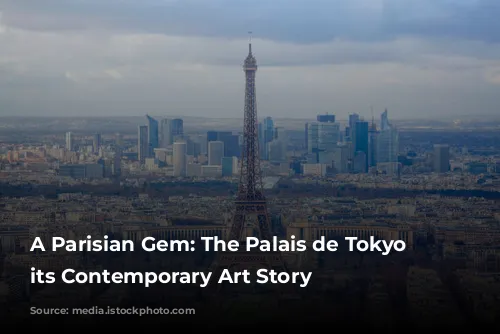The Palais de Tokyo, a majestic building gracing the 16th arrondissement of Paris, stands as a beacon of modern and contemporary art. Located near the iconic Trocadéro, this architectural marvel houses two prominent institutions: the Musée d’Art Moderne de Paris in its eastern wing, and the Palais de Tokyo / Site de création contemporaine, a haven for contemporary art exhibitions, in its western wing.
From the Seine to the Palais
The Palais de Tokyo derives its name from the Avenue de Tokio, which in turn references the Avenue de New-York that separates the building from the River Seine. This avenue was previously known as Quai Debilly. The Palais de Tokyo is easily accessible via the Iéna metro station on Line 9.

A History of Art and Innovation
Inaugurated in 1937, the Palais de Tokyo was initially known as the Palais des Musées d’art moderne, a testament to its early dedication to art. Over the years, it has served as a platform for various projects and organizations, including the Musée d’art et d’essai, the FEMIS, and the Centre national de la photographie. In 1986, it transformed into the Palais du cinéma before ultimately becoming the Site de création contemporaine in 2002, embracing its current role as a dynamic hub for contemporary artistic expression.
This transformation was spearheaded by the architect duo Anne Lacaton and Jean-Philippe Vassal, who subsequently received the prestigious Pritzker Prize. With a focus on emerging art scenes and a commitment to temporary exhibitions, the Palais de Tokyo proudly carries the title of Europe’s largest non-collecting contemporary art museum.
A Hub of Artistic Exploration
The Palais de Tokyo isn’t simply a space for exhibitions, but a vibrant hub for creativity. In 2002, under the leadership of Nicolas Bourriaud and Jérôme Sans, the Site de création contemporaine was established, quickly becoming a major player in the international art scene.
The Palais de Tokyo boasts a residency program, known as the Pavillon, which has fostered the talents of over 130 international artists since its inception in 2001. Designed as a studio and laboratory for artists and curators, the Pavillon allows participants to explore their creative potential in an experimental environment.
A Literary Journey: The Palais / Magazine
The Palais de Tokyo goes beyond the visual realm, extending its reach into the literary world through its Palais / magazine. Launched in 2006 by Marc-Olivier Wahler, this publication features insightful articles exploring diverse artistic themes, often aligning with the museum’s current exhibitions.
The Palais / magazine, published three times a year, presents a rich blend of photography, artistic media, essays, and experimental approaches, providing readers with a multifaceted exploration of artistic concepts. This magazine further reinforces the Palais de Tokyo’s commitment to fostering an innovative and engaging dialogue with the artistic world.
A Legacy of Artistic Exploration
The Palais de Tokyo has played a crucial role in shaping the contemporary art landscape, offering a platform for emerging artists and providing audiences with a unique and constantly evolving experience. From its early days as a museum of modern art to its current identity as a dynamic center for contemporary creation, the Palais de Tokyo continues to inspire and challenge, making it a must-visit for art enthusiasts.
